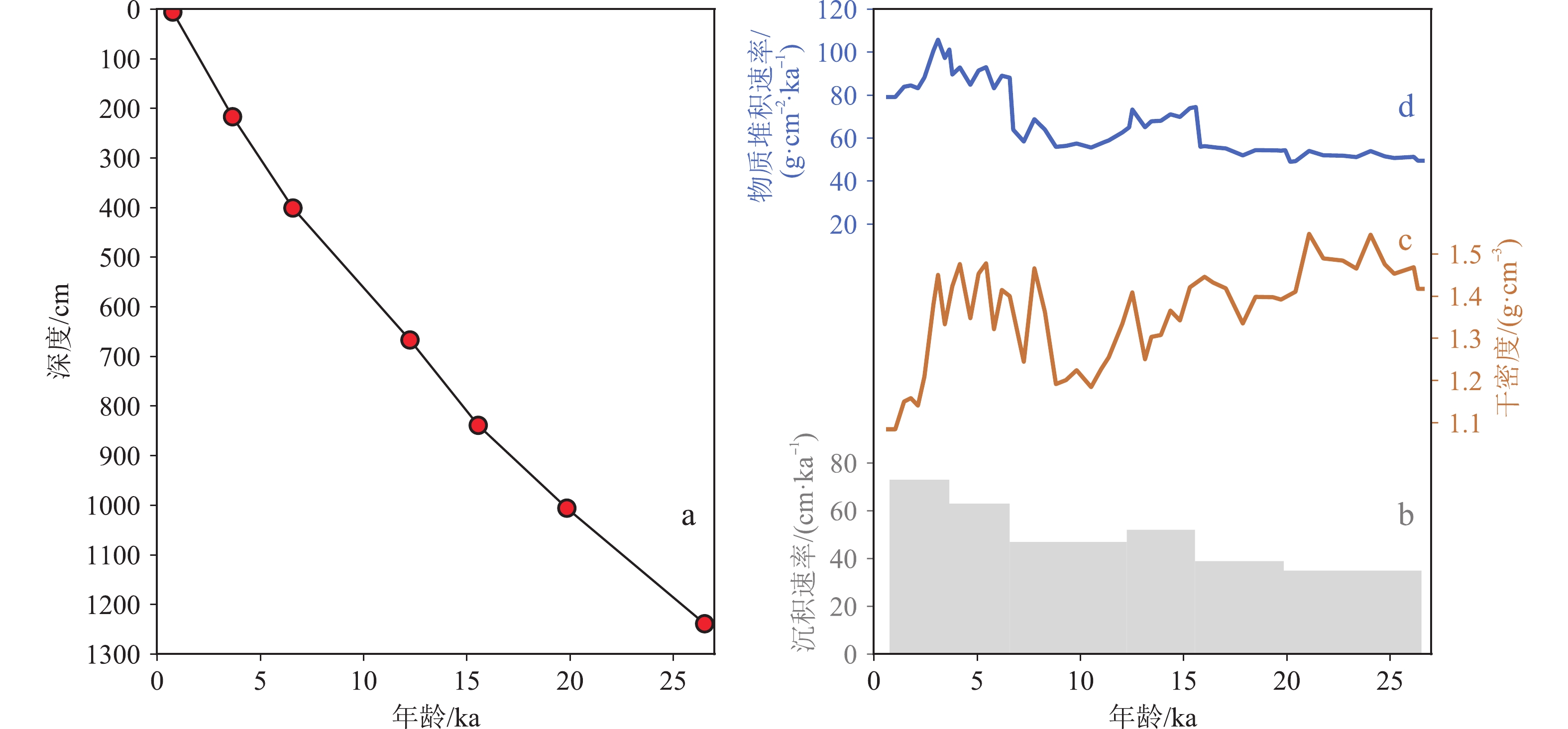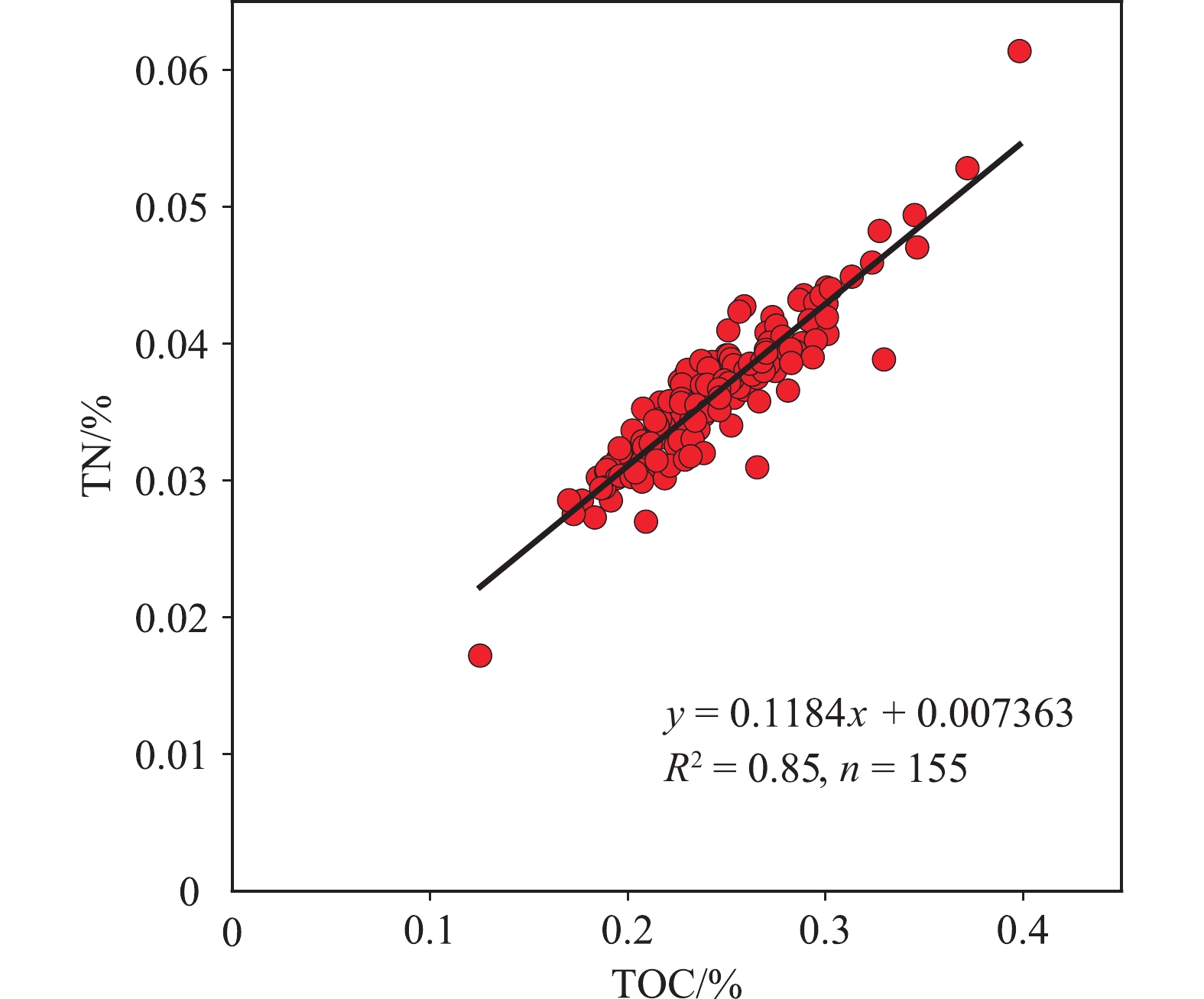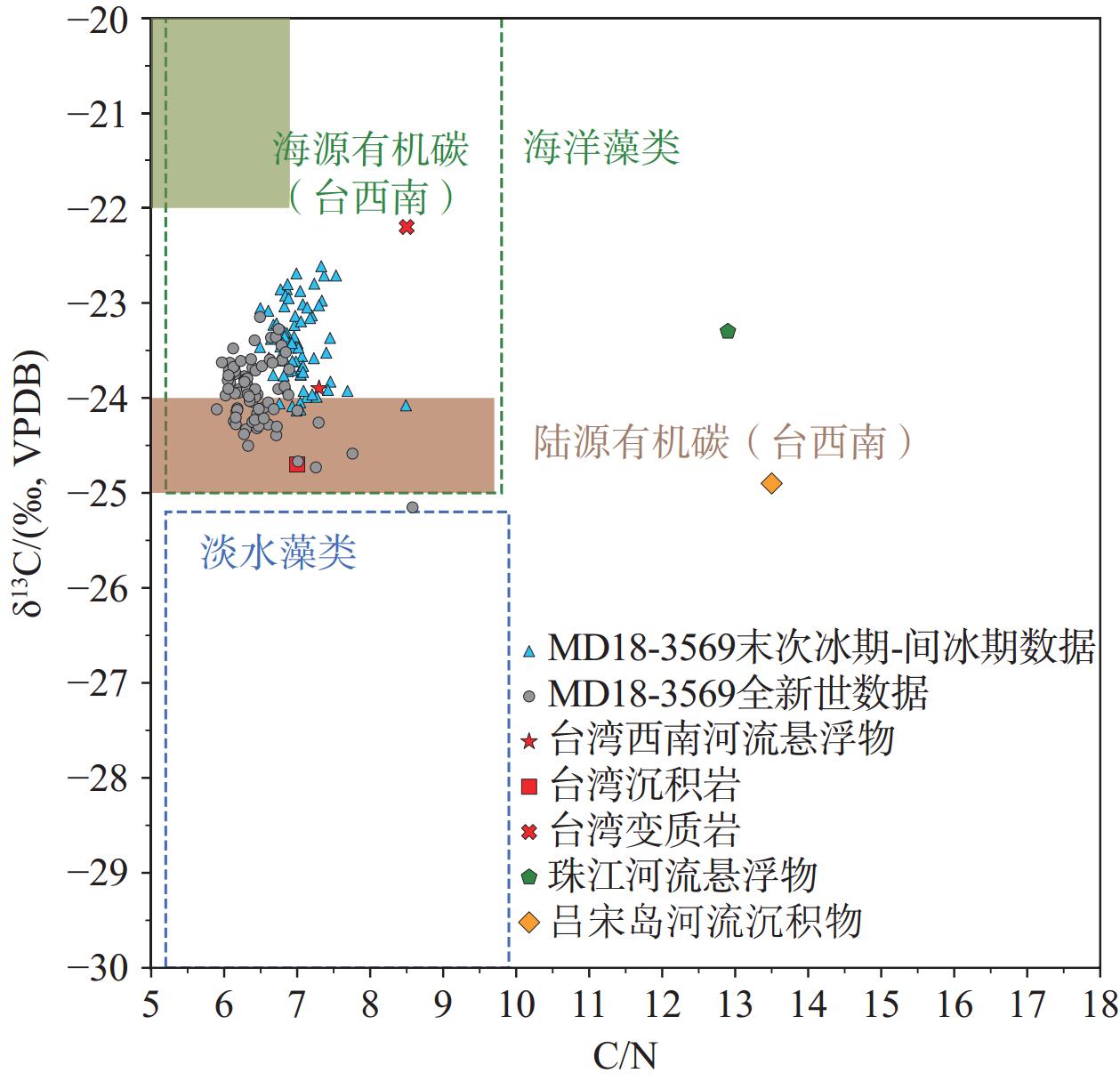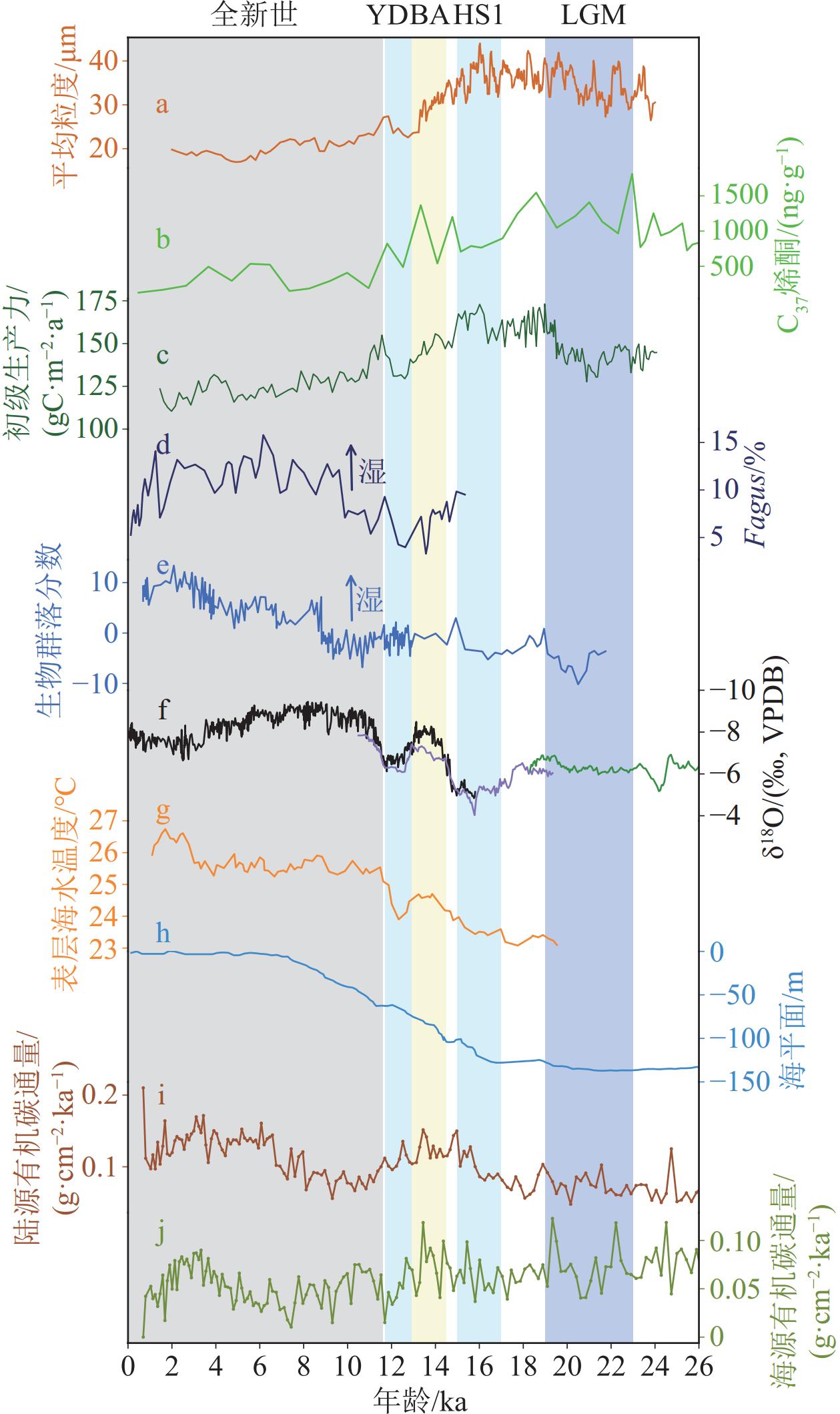Variation of organic carbon flux in the northeastern South China Sea since the Last Glacial Maximum and the driving mechanism
-
摘要:
通过分析南海东北部台湾西南岸外MD18-3569柱状样岩芯的总有机碳、总氮和有机碳同位素,探讨了末次冰盛期(LGM)以来南海东北部有机碳通量变化及其驱动机制。结果表明,总有机碳和总氮含量分别为0.13%~0.40%和0.017%~0.061%,均呈冰期高、全新世低的特征;C/N比值和有机碳同位素值分别为5.90~8.58和−25.15‰~−22.61‰,指示了研究站位海陆混合的有机碳来源,海源有机碳主要来自于海洋初级生产者(海洋藻类为主),陆源有机碳主要来自台湾西南部河流。海陆端元模型计算的海陆有机碳通量结果显示,海源有机碳和陆源有机碳通量分别为0.01~0.12 g·cm−2·ka−1和0.05~0.21 g·cm−2·ka−1。LGM以来,海源有机碳通量总体呈下降趋势,冰期高海源有机碳通量可能是由于冰期较强的东亚冬季风加强了海水垂向混合,导致上层海水营养物质含量升高,从而提高了海洋初级生产力;陆源有机碳通量呈自LGM以来的上升趋势,可能主要受到东亚夏季风带来的降水对台湾西南河流通量的影响,冰期以来的海平面变化通过改变河口位置也对这一过程起到了一定作用。这表明LGM以来,东亚季风系统对南海东北部有机碳埋藏过程具有非常重要的影响。
Abstract:To investigate the variations of organic carbon flux and their driving mechanisms since the Last Glacial Maximum (LGM), we examined The variation of total organic carbon (TOC), total nitrogen (TN), and stable organic carbon isotope (δ13CTOC) in core MD18-3569 collected offshore of southwestern Taiwan in the northeastern part of the South China Sea. Results indicate that the values of TOC and TN ranged from 0.13% to 0.40% and 0.017% to 0.061%, which exhibit a characteristic pattern of higher values during glacial periods and lower values during the Holocene. The values of C/N ratio and δ13CTOC ranged from 5.90 to 8.58 and −25.15‰~−22.61‰, which indicate a mixed marine-terrigenous source for organic carbon at MD18-3569. Marine organic carbon mainly originates from marine primary producers, primarily marine algae, while terrigenous organic carbon primarily comes from rivers in southwestern Taiwan. According to the marine-terrigenous end-member model calculations, the values of marine organic carbon flux and terrigenous organic carbon flux ranged 0.01~0.12 g·cm−2·ka−1 and 0.05~0.21 g·cm−2·ka−1, respectively. The marine organic flux had generally been decreased since the LGM. The high marine organic carbon flux during the glacial period might be due to stronger East Asian winter monsoon that enhanced the vertical mixing of seawater, which increased the nutrient content and consequently the marine primary productivity in the upper seawater. In contrast, terrigenous organic carbon flux showed an increasing trend since the LGM duo likely to the impact of precipitation from the East Asian summer monsoon on the rivers in the southwestern Taiwan. Sea level changes since the LGM also played a certain role in this process by the shifting of river mouth. Therefore, the East Asian monsoon system resulted in significant influence on the burial of organic carbon in the northeastern South China Sea since the LGM.
-

-
[1] Berner R A. Biogeochemical cycles of carbon and sulfur and their effect on atmospheric oxygen over Phanerozoic time[J]. Global and Planetary Change, 1989, 1(1-2):97-122. doi: 10.1016/0921-8181(89)90018-0
[2] Honjo S, Manganini S J, Krishfield R A, et al. Particulate organic carbon fluxes to the ocean interior and factors controlling the biological pump: a synthesis of global sediment trap programs since 1983[J]. Progress in Oceanography, 2008, 76(3):217-285. doi: 10.1016/j.pocean.2007.11.003
[3] McKee B A, Aller R C, Allison M A, et al. Transport and transformation of dissolved and particulate materials on continental margins influenced by major rivers: benthic boundary layer and seabed processes[J]. Continental Shelf Research, 2004, 24(7-8):899-926. doi: 10.1016/j.csr.2004.02.009
[4] Bianchi T S, Allison M A. Large-river delta-front estuaries as natural “recorders” of global environmental change[J]. Proceedings of the National Academy of Sciences of the United States of America, 2009, 106(20):8085-8092.
[5] Canuel E A, Cammer S S, McIntosh H A, et al. Climate change impacts on the organic carbon cycle at the land-ocean interface[J]. Annual Review of Earth and Planetary Sciences, 2012, 40:685-711. doi: 10.1146/annurev-earth-042711-105511
[6] Liu K K, Chao S Y, Shaw P T, et al. Monsoon-forced chlorophyll distribution and primary production in the South China Sea: observations and a numerical study[J]. Deep Sea Research Part I:Oceanographic Research Papers, 2002, 49(8):1387-1412. doi: 10.1016/S0967-0637(02)00035-3
[7] Chen Y L L. Spatial and seasonal variations of nitrate-based new production and primary production in the South China Sea[J]. Deep Sea Research Part I:Oceanographic Research Papers, 2005, 52(2):319-340. doi: 10.1016/j.dsr.2004.11.001
[8] Shaw P T, Chao S Y. Surface circulation in the South China sea[J]. Deep Sea Research Part I:Oceanographic Research Papers, 1994, 41(11-12):1663-1683. doi: 10.1016/0967-0637(94)90067-1
[9] Ding Y, Chan J C L. The East Asian summer monsoon: an overview[J]. Meteorology and Atmospheric Physics, 2005, 89(1-4):117-142. doi: 10.1007/s00703-005-0125-z
[10] Loo Y Y, Billa L, Singh A. Effect of climate change on seasonal monsoon in Asia and its impact on the variability of monsoon rainfall in Southeast Asia[J]. Geoscience Frontiers, 2015, 6(6):817-823. doi: 10.1016/j.gsf.2014.02.009
[11] Wu B Y, Wang J. Winter Arctic oscillation, Siberian high and East Asian winter monsoon[J]. Geophysical Research Letters, 2002, 29(19):1897.
[12] Wang L, Li J J, Lu H Y, et al. The East Asian winter monsoon over the last 15, 000 years: its links to high-latitudes and tropical climate systems and complex correlation to the summer monsoon[J]. Quaternary Science Reviews, 2012, 32:131-142. doi: 10.1016/j.quascirev.2011.11.003
[13] Ding X D, Zheng L W, Li D W, et al. Lacustrine record of centennial-and millennial-scale rainfall variability of the East Asian summer monsoon during the last deglaciation: multi-proxy evidence from Taiwan[J]. Palaeogeography, Palaeoclimatology, Palaeoecology, 2016, 450:38-49. doi: 10.1016/j.palaeo.2016.02.048
[14] Ding X D, Zheng L W, Zheng X F, et al. Holocene East Asian summer monsoon rainfall variability in Taiwan[J]. Frontiers in Earth Science, 2020, 8:234. doi: 10.3389/feart.2020.00234
[15] Liu Z F, Colin C, Li X J, et al. Clay mineral distribution in surface sediments of the northeastern South China Sea and surrounding fluvial drainage basins: source and transport[J]. Marine Geology, 2010, 277(1-4):48-60. doi: 10.1016/j.margeo.2010.08.010
[16] Liu J G, Yan W, Chen Z, et al. Sediment sources and their contribution along northern coast of the South China Sea: evidence from clay minerals of surface sediments[J]. Continental Shelf Research, 2012, 47:156-164. doi: 10.1016/j.csr.2012.07.013
[17] Kao S J, Shiah F K, Wang C H, et al. Efficient trapping of organic carbon in sediments on the continental margin with high fluvial sediment input off southwestern Taiwan[J]. Continental Shelf Research, 2006, 26(20):2520-2537. doi: 10.1016/j.csr.2006.07.030
[18] Hu D K, Böning P, Köhler C M, et al. Deep sea records of the continental weathering and erosion response to East Asian monsoon intensification since 14 ka in the South China Sea[J]. Chemical Geology, 2012, 326-327:1-18. doi: 10.1016/j.chemgeo.2012.07.024
[19] Liu Z F, Zhao Y L, Colin C, et al. Source-to-sink transport processes of fluvial sediments in the South China Sea[J]. Earth-Science Reviews, 2016, 153:238-273. doi: 10.1016/j.earscirev.2015.08.005
[20] Liu J G, Steinke S, Vogt C, et al. Temporal and spatial patterns of sediment deposition in the northern South China Sea over the last 50, 000 years[J]. Palaeogeography, Palaeoclimatology, Palaeoecology, 2017, 465:212-224. doi: 10.1016/j.palaeo.2016.10.033
[21] Wang B, Lei H Y, Huang F F, et al. Effect of sea-level change on deep-sea sedimentary records in the northeastern South China Sea over the past 42 kyr[J]. Geofluids, 2020, 2020:8814545.
[22] 秦琳, 万世明. 末次冰期以来南海东北部陆源有机碳埋藏通量演变: 海平面和季风驱动[J]. 海洋与湖沼, 2020, 51(4):875-888
QIN Lin, WAN Shiming. Sea level change and monsoon dominated evolution of terrigenous organic carbon burial flux in the northeastern South China Sea since the last glacial[J]. Oceanologia et Limnologia Sinica, 2020, 51(4):875-888.]
[23] Blair N E, Aller R C. The fate of terrestrial organic carbon in the marine environment[J]. Annual Review of Marine Science, 2012, 4:401-423. doi: 10.1146/annurev-marine-120709-142717
[24] 陈越, 王跃, 党皓文, 等. 南海东北部末次冰盛期以来的水文气候变化[J]. 第四纪研究, 2021, 41(4):1031-1043
CHEN Yue, WANG Yue, DANG Haowen, et al. Hydroclimatic changes in the northeastern South China Sea since the last glacial maximum[J]. Quaternary Sciences, 2021, 41(4):1031-1043.]
[25] Hayes J M. Factors controlling 13C contents of sedimentary organic compounds: principles and evidence[J]. Marine Geology, 1993, 113(1-2):111-125. doi: 10.1016/0025-3227(93)90153-M
[26] Müller P J. CN ratios in Pacific deep-sea sediments: effect of inorganic ammonium and organic nitrogen compounds sorbed by clays[J]. Geochimica et Cosmochimica Acta, 1977, 41(6):765-776. doi: 10.1016/0016-7037(77)90047-3
[27] Meyers P A. Organic geochemical proxies of paleoceanographic, paleolimnologic, and paleoclimatic processes[J]. Organic Geochemistry, 1997, 27(5-6):213-250. doi: 10.1016/S0146-6380(97)00049-1
[28] Hedges J I, Keil R G. Sedimentary organic matter preservation: an assessment and speculative synthesis[J]. Marine Chemistry, 1995, 49(2-3):81-115. doi: 10.1016/0304-4203(95)00008-F
[29] Milliman J D, Kao S J. Hyperpycnal discharge of fluvial sediment to the ocean: impact of super-typhoon Herb (1996) on Taiwanese rivers[J]. The Journal of Geology, 2005, 113(5):503-516. doi: 10.1086/431906
[30] Lin B Z, Liu Z F, Eglinton T I, et al. Island-wide variation in provenance of riverine sedimentary organic carbon: a case study from Taiwan[J]. Earth and Planetary Science Letters, 2020, 539:116238. doi: 10.1016/j.jpgl.2020.116238
[31] Lamb A L, Wilson G P, Leng M J. A review of coastal palaeoclimate and relative sea-level reconstructions using δ13C and C/N ratios in organic material[J]. Earth-Science Reviews, 2006, 75(1-4):29-57. doi: 10.1016/j.earscirev.2005.10.003
[32] Lin B Z, Liu Z F, Eglinton T I, et al. Perspectives on provenance and alteration of suspended and sedimentary organic matter in the subtropical Pearl River system, South China[J]. Geochimica et Cosmochimica Acta, 2019, 259:270-287. doi: 10.1016/j.gca.2019.06.018
[33] Lin B Z, Liu Z F, Eglinton T I, et al. Organic matter compositions and loadings in river sediments from humid tropical volcanic Luzon Island of the Philippines[J]. Journal of Geophysical Research:Biogeosciences, 2021, 126(7):e2020JG006192. doi: 10.1029/2020JG006192
[34] Kao S J, Liu K K. Stable carbon and nitrogen isotope systematics in a human‐disturbed watershed (Lanyang‐Hsi) in Taiwan and the estimation of biogenic particulate organic carbon and nitrogen fluxes[J]. Global Biogeochemical Cycles, 2000, 14(1):189-198. doi: 10.1029/1999GB900079
[35] Hilton R G, Galy A, Hovius N, et al. The isotopic composition of particulate organic carbon in mountain rivers of Taiwan[J]. Geochimica et Cosmochimica Acta, 2010, 74(11):3164-3181. doi: 10.1016/j.gca.2010.03.004
[36] Dadson S J, Hovius N, Chen H, et al. Links between erosion, runoff variability and seismicity in the Taiwan orogen[J]. Nature, 2003, 426(6967):648-651. doi: 10.1038/nature02150
[37] Liu J T, Hsu R T, Hung J J, et al. From the highest to the deepest: the Gaoping River–Gaoping Submarine Canyon dispersal system[J]. Earth-Science Reviews, 2016, 153:274-300. doi: 10.1016/j.earscirev.2015.10.012
[38] 李丽, 王慧, 罗布次仁, 等. 南海北部4万年以来有机碳和碳酸盐含量变化及古海洋学意义[J]. 海洋地质与第四纪地质, 2008, 28(6):79-85
LI Li, WANG Hui, LUO Buchiren, et al. The characterizations and paleoceanographic significances of organic and inorganic carbon in northern South China Sea during past 40 ka[J]. Marine Geology & Quaternary Geology, 2008, 28(6):79-85.]
[39] Shultz D J, Calder J A. Organic carbon 13C12C variations in estuarine sediments[J]. Geochimica et Cosmochimica Acta, 1976, 40(4):381-385. doi: 10.1016/0016-7037(76)90002-8
[40] Beaufort L, Lancelot Y, Camberlin P, et al. Insolation cycles as a major control of equatorial Indian Ocean primary production[J]. Science, 1997, 278(5342):1451-1454. doi: 10.1126/science.278.5342.1451
[41] de Garidel‐Thoron T, Beaufort L, Linsley B K, et al. Millennial‐scale dynamics of the east Asian winter monsoon during the last 200, 000 years[J]. Paleoceanography, 2001, 16(5):491-502. doi: 10.1029/2000PA000557
[42] Zhang H R, Liu C L, Jin X B, et al. Dynamics of primary productivity in the northern South China Sea over the past 24, 000 years[J]. Geochemistry, Geophysics, Geosystems, 2016, 17(12):4878-4891. doi: 10.1002/2016GC006602
[43] Hernández-Almeida I, Ausín B, Saavedra-Pellitero M, et al. Quantitative reconstruction of primary productivity in low latitudes during the last glacial maximum and the mid-to-late Holocene from a global Florisphaera profunda calibration dataset[J]. Quaternary Science Reviews, 2019, 205:166-181. doi: 10.1016/j.quascirev.2018.12.016
[44] Schubert C J, Villanueva J, Calvert S E, et al. Stable phytoplankton community structure in the Arabian Sea over the past 200, 000 years[J]. Nature, 1998, 394(6693):563-566. doi: 10.1038/29047
[45] Sicre M A, Ternois Y, Paterne M, et al. Biomarker stratigraphic records over the last 150 kyears off the NW African coast at 25°N[J]. Organic Geochemistry, 2000, 31(6):577-588. doi: 10.1016/S0146-6380(00)00021-8
[46] 李丽, 王慧, 汪品先. 南海北部17937岩心四万年来古环境变化的分子有机地球化学记录[J]. 地球科学-中国地质大学学报, 2008, 33(6):793-799 doi: 10.3799/dqkx.2008.095
LI Li, WANG Hui, WANG Pinxian. Molecular organic geochemical record of paleoenvironmental changes of core 17937 in northern South China sea since 40 ka[J]. Earth Science-Journal of China University of Geosciences, 2008, 33(6):793-799.] doi: 10.3799/dqkx.2008.095
[47] Zhou X Q, Duchamp‐Alphonse S, Kageyama M, et al. Variations of primary productivity in the northwestern Arabian Sea during the last23 000 years and their paleoclimatological implications[J]. Paleoceanography and Paleoclimatology, 2022, 37(10):e2022PA004453. doi: 10.1029/2022PA004453
[48] Sun Y B, Clemens S C, Morrill C, et al. Influence of Atlantic meridional overturning circulation on the East Asian winter monsoon[J]. Nature Geoscience, 2012, 5(1):46-49. doi: 10.1038/ngeo1326
[49] Zhao M X, Wang P X, Tian J, et al. Biogeochemistry and the carbon reservoir[M]//Wang P X, Li Q Y. The South China Sea: Paleoceanography and Sedimentology. Dordrecht: Springer, 2009: 439-483.
[50] Moodley L, Middelburg J J, Herman P M J, et al. Oxygenation and organic-matter preservation in marine sediments: direct experimental evidence from ancient organic carbon–rich deposits[J]. Geology, 2005, 33(11):889-892. doi: 10.1130/G21731.1
[51] Burdige D J. Preservation of organic matter in marine sediments: controls, mechanisms, and an imbalance in sediment organic carbon budgets?[J]. Chemical Reviews, 2007, 107(2):467-485. doi: 10.1021/cr050347q
[52] Zonneveld K A F, Versteegh G J M, Kasten S, et al. Selective preservation of organic matter in marine environments; processes and impact on the sedimentary record[J]. Biogeosciences, 2010, 7(2):483-511. doi: 10.5194/bg-7-483-2010
[53] Chen C S, Chen Y L, Liu C L, et al. Statistics of heavy rainfall occurrences in Taiwan[J]. Weather and Forecasting, 2007, 22(5):981-1002. doi: 10.1175/WAF1033.1
[54] Tung Y S, Wang S Y S, Chu J L, et al. Projected increase of the East Asian summer monsoon (Meiyu) in Taiwan by climate models with variable performance[J]. Meteorological Applications, 2020, 27(1):e1886. doi: 10.1002/met.1886
[55] Henny L, Thorncroft C D, Hsu H H, et al. Extreme rainfall in Taiwan: seasonal statistics and trends[J]. Journal of Climate, 2021, 34(12):4711-4731. doi: 10.1175/JCLI-D-20-0999.1
[56] Wang Y J, Cheng H, Edwards R L, et al. A high-resolution absolute-dated late Pleistocene monsoon record from Hulu Cave, China[J]. Science, 2001, 294(5550):2345-2348. doi: 10.1126/science.1064618
[57] Dykoski C A, Edwards R L, Cheng H, et al. A high-resolution, absolute-dated Holocene and deglacial Asian monsoon record from Dongge Cave, China[J]. Earth and Planetary Science Letters, 2005, 233(1-2):71-86. doi: 10.1016/j.jpgl.2005.01.036
[58] Zhang H W, Zhang X, Cai Y J, et al. A data-model comparison pinpoints Holocene spatiotemporal pattern of East Asian summer monsoon[J]. Quaternary Science Reviews, 2021, 261:106911. doi: 10.1016/j.quascirev.2021.106911
[59] Ni J, Yu G, Harrison S P, et al. Palaeovegetation in China during the late Quaternary: biome reconstructions based on a global scheme of plant functional types[J]. Palaeogeography, Palaeoclimatology, Palaeoecology, 2010, 289(1-4):44-61. doi: 10.1016/j.palaeo.2010.02.008
[60] Yue Y F, Zheng Z, Huang K Y, et al. A continuous record of vegetation and climate change over the past 50, 000 years in the Fujian Province of eastern subtropical China[J]. Palaeogeography, Palaeoclimatology, Palaeoecology, 2012, 365-366:115-123. doi: 10.1016/j.palaeo.2012.09.018
[61] Yu S H, Zheng Z, Chen F, et al. A last glacial and deglacial pollen record from the northern South China Sea: new insight into coastal-shelf paleoenvironment[J]. Quaternary Science Reviews, 2017, 157:114-128. doi: 10.1016/j.quascirev.2016.12.012
[62] Zhou X, Sun L G, Zhan T, et al. Time-transgressive onset of the Holocene Optimum in the East Asian monsoon region[J]. Earth and Planetary Science Letters, 2016, 456:39-46. doi: 10.1016/j.jpgl.2016.09.052
[63] Cheddadi R. How the Asian subtropical area became evergreen since the Last Glacial Maximum[J]. Past Global Changes Magazine, 2020, 28(1):6-7.
[64] 刘茂松, 洪必恭. 中国壳斗科的地理分布及其与气候条件的关系[J]. 植物生态学报, 1998, 22(1):41-50 doi: 10.3321/j.issn:1005-264X.1998.01.005
LIU Maosong, HONG Bigong. The distribution of Fagaceae in China and its relationship with climatic and geographic characters[J]. Acta Phytoecologica Sinica, 1998, 22(1):41-50.] doi: 10.3321/j.issn:1005-264X.1998.01.005
[65] Zhong W, Cao J Y, Xue J B, et al. A 15, 400-year record of climate variation from a subalpine lacustrine sedimentary sequence in the western Nanling Mountains in South China[J]. Quaternary Research, 2015, 84(2):246-254. doi: 10.1016/j.yqres.2015.06.002
[66] Yu S W, Tsai L L, Talling P J, et al. Sea level and climatic controls on turbidite occurrence for the past 26 kyr on the flank of the Gaoping Canyon off SW Taiwan[J]. Marine Geology, 2017, 392:140-150. doi: 10.1016/j.margeo.2017.08.011
[67] Jiwarungrueangkul T, Liu Z F, Zhao Y L. Terrigenous sediment input responding to sea level change and East Asian monsoon evolution since the last deglaciation in the southern South China Sea[J]. Global and Planetary Change, 2019, 174:127-137. doi: 10.1016/j.gloplacha.2019.01.011
[68] Xu Z K, Wan S M, Colin C, et al. Enhanced terrigenous organic matter input and productivity on the western margin of the Western Pacific Warm Pool during the Quaternary sea-level lowstands: forcing mechanisms and implications for the global carbon cycle[J]. Quaternary Science Reviews, 2020, 232:106211. doi: 10.1016/j.quascirev.2020.106211
[69] 鲍才旺. 珠江口陆架区埋藏古河道与古三角洲[J]. 海洋地质与第四纪地质, 1995, 15(2):25-34
BAO Caiwang. Buried ancient channels and deltas in the Zhujiang River mouth shelf area[J]. Marine Geology & Quaternary Geology, 1995, 15(2):25-34.]
-




 下载:
下载:





